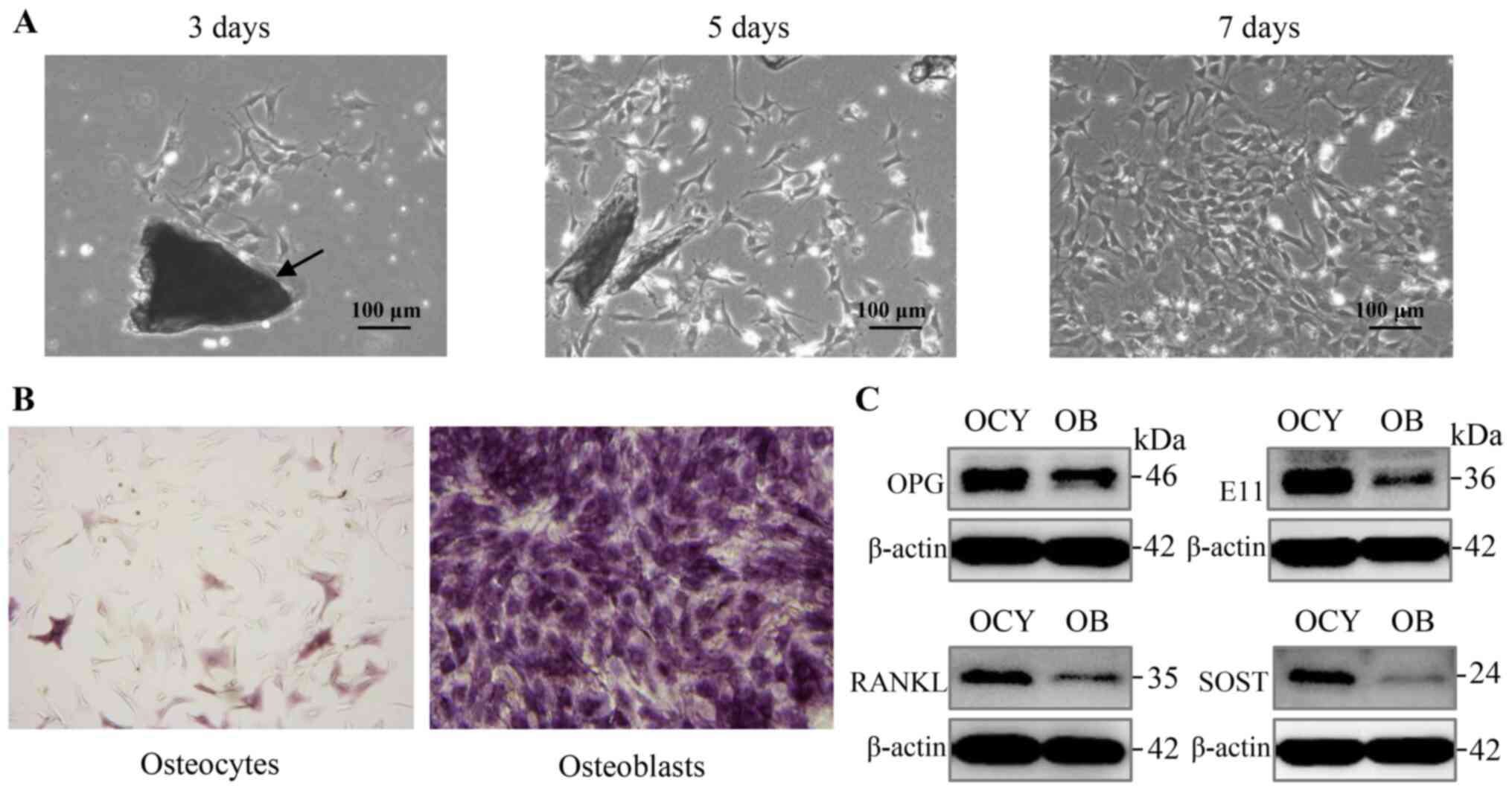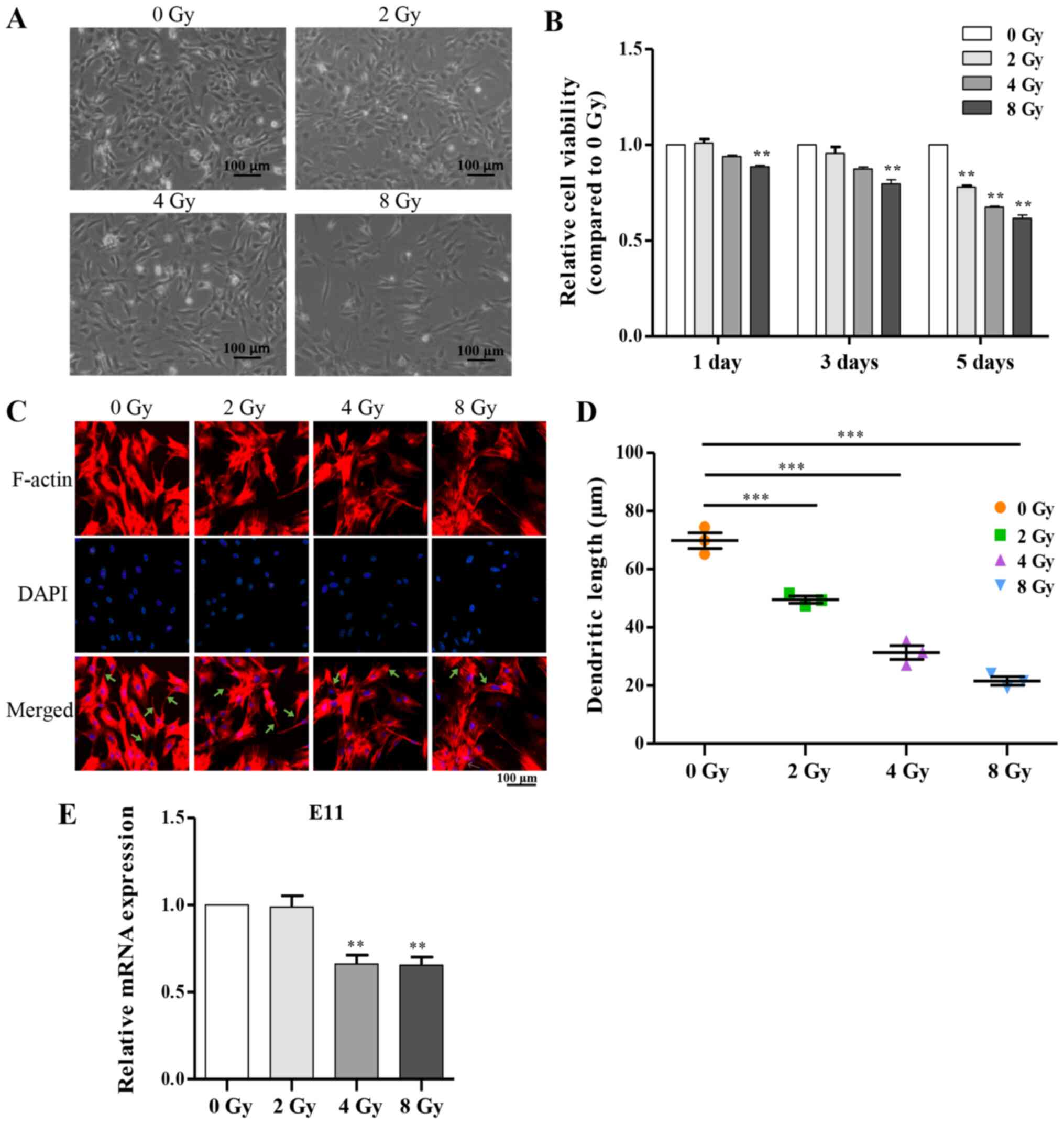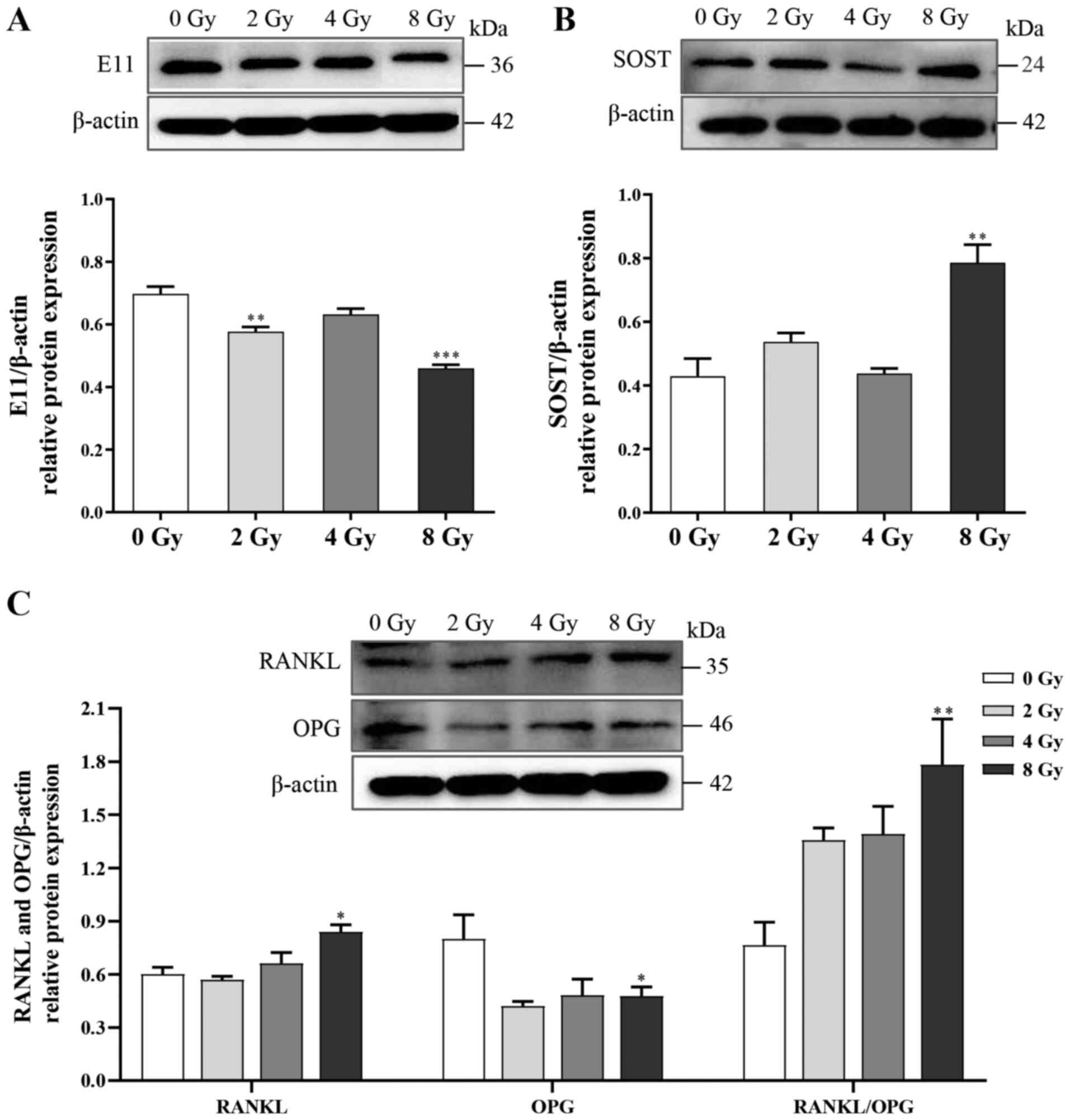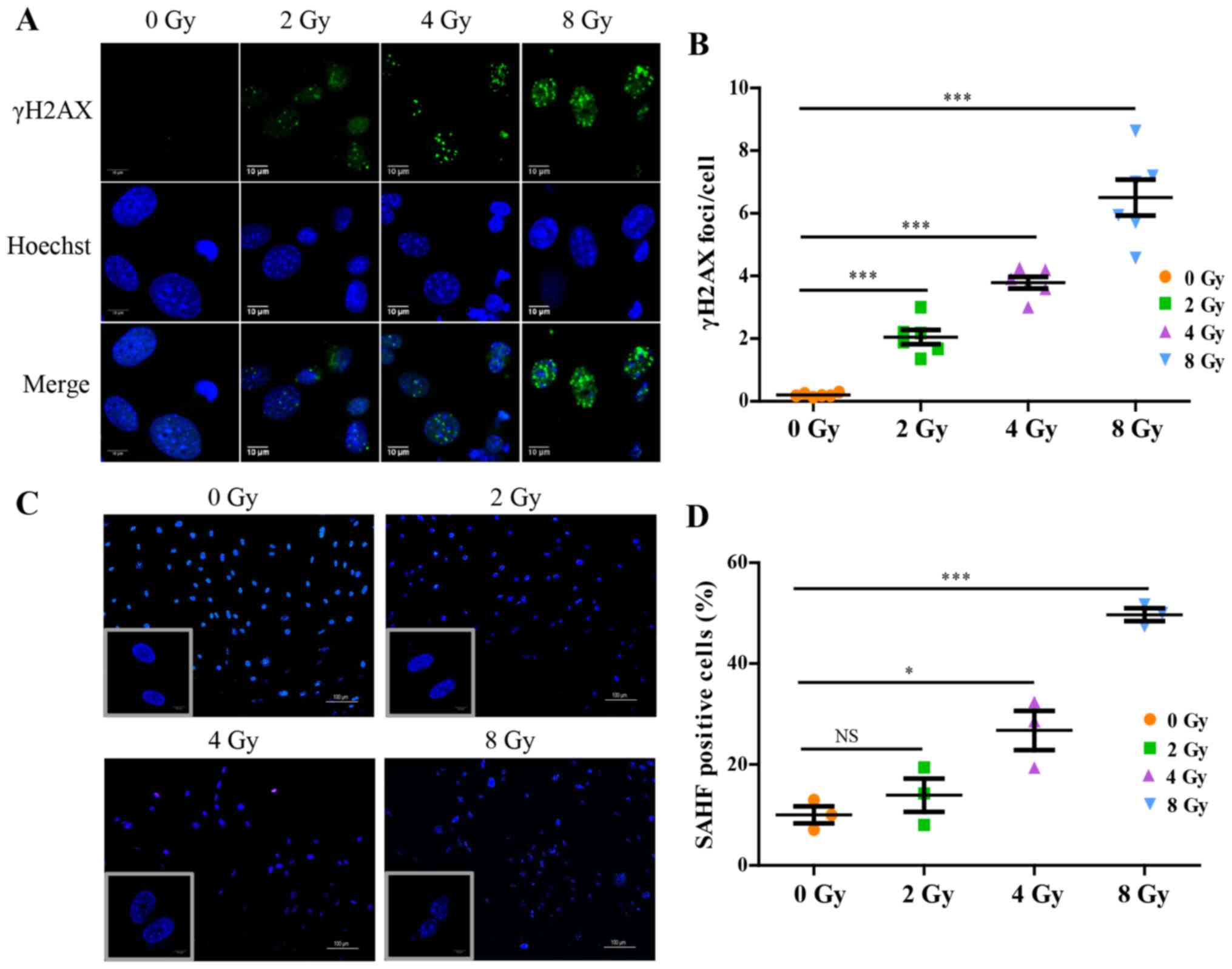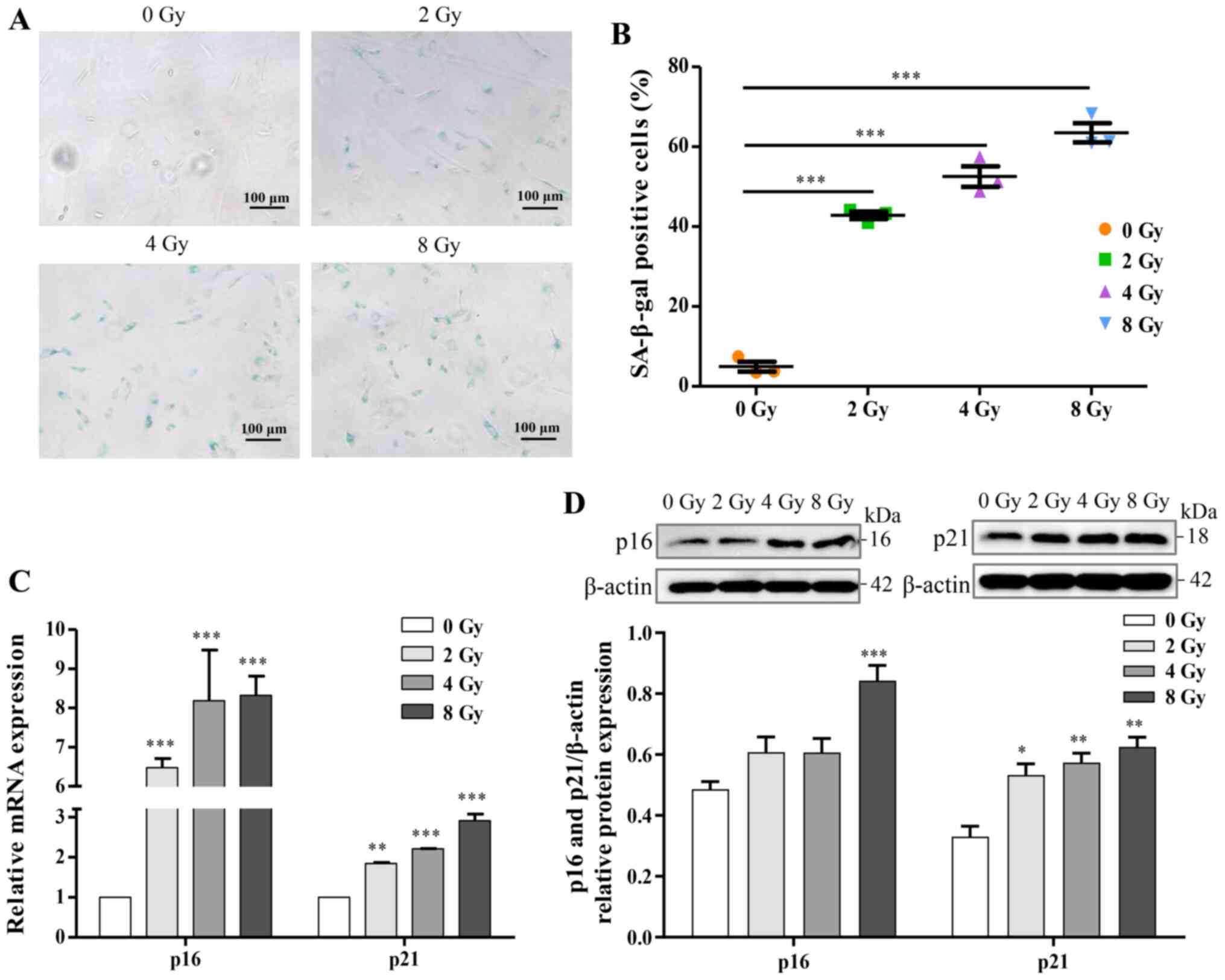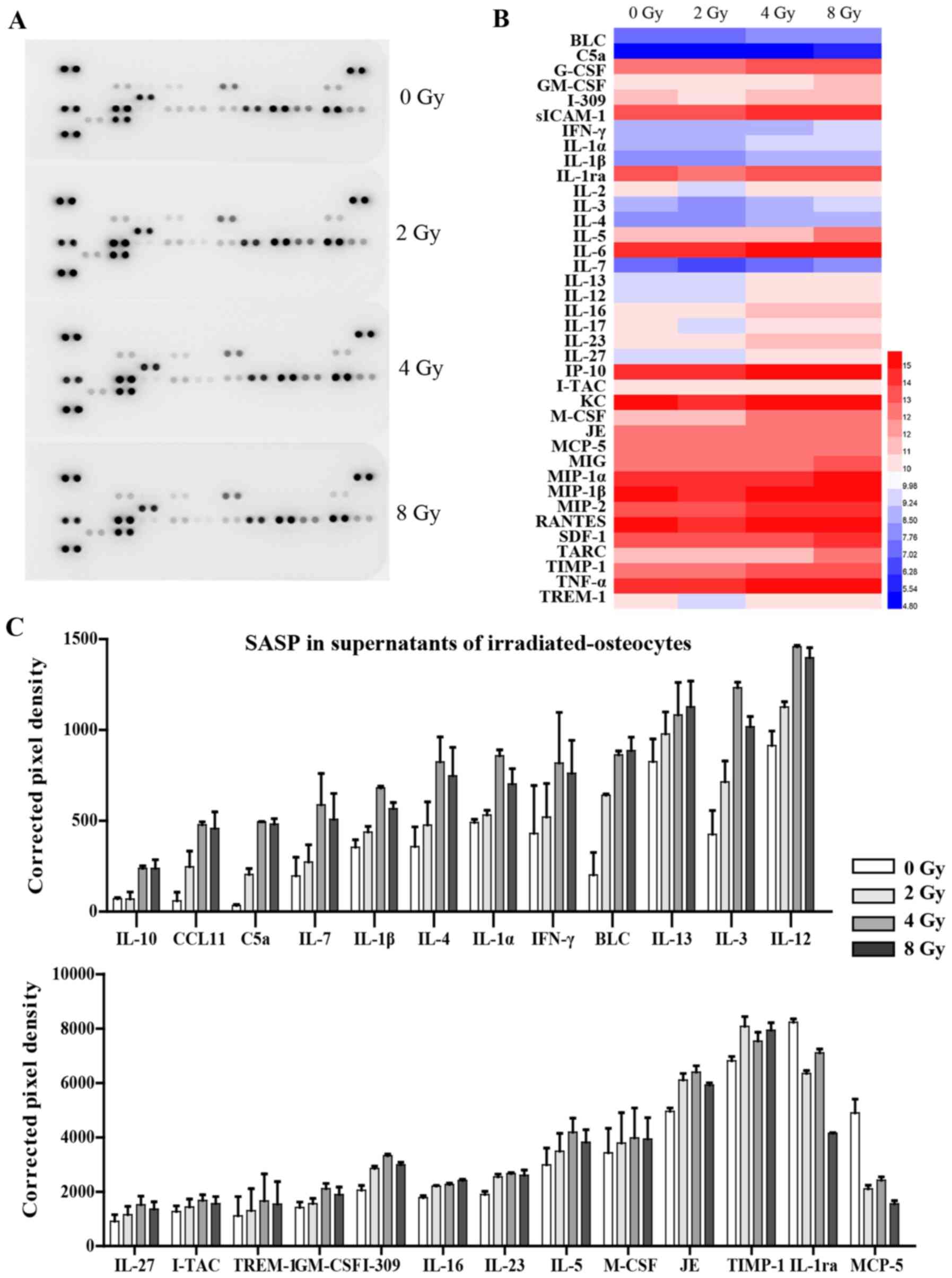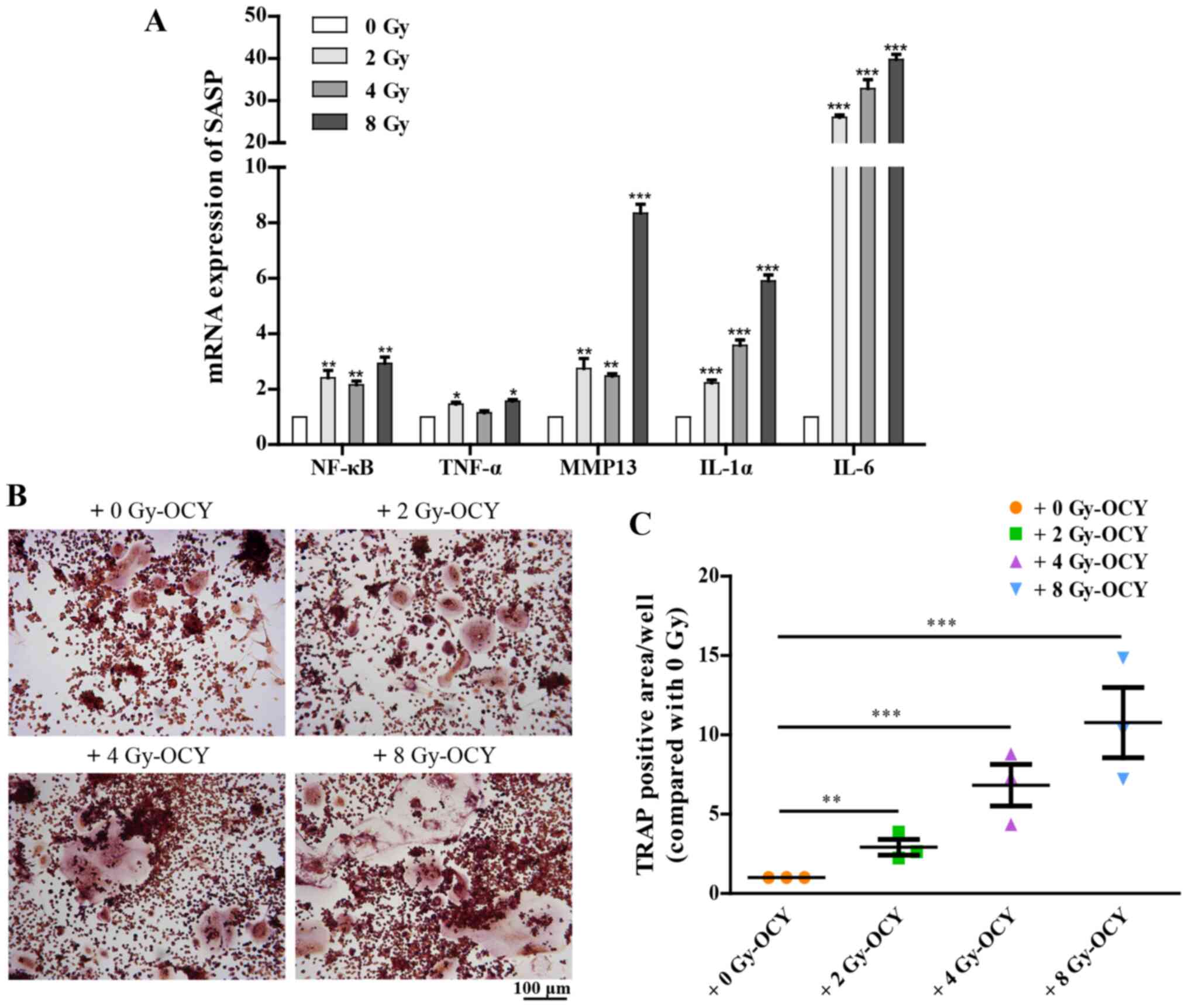|
1
|
Allen C, Her S and Jaffray DA:
Radiotherapy for cancer: Present and future. Adv Drug Deliv Rev.
109:1–2. 2017. View Article : Google Scholar : PubMed/NCBI
|
|
2
|
Mendes EM, Irie MS, Rabelo GD, Borges JS,
Dechichi P, Diniz RS and Soares PBF: Effects of ionizing radiation
on woven bone: Influence on the osteocyte lacunar network, collagen
maturation, and microarchitecture. Clin Oral Investig.
24:2763–2771. 2020. View Article : Google Scholar
|
|
3
|
Schmeler KM, Jhingran A, Iyer RB, Sun CC,
Eifel PJ, Soliman PT, Ramirez PT, Frumovitz M, Bodurka DC and Sood
AK: Pelvic fractures after radiotherapy for cervical cancer:
Implications for survivors. Cancer. 116:625–630. 2010. View Article : Google Scholar : PubMed/NCBI
|
|
4
|
Zhang J, Qiu X, Xi K, Hu W, Pei H, Nie J,
Wang Z, Ding J, Shang P, Li B and Zhou G: Therapeutic ionizing
radiation induced bone loss: A review of in vivo and in vitro
findings. Connect Tissue Res. 59:509–522. 2018. View Article : Google Scholar : PubMed/NCBI
|
|
5
|
Saintigny Y, Cruet-Hennequart S, Hamdi DH,
Chevalier F and Lefaix JL: Impact of therapeutic irradiation on
healthy articular cartilage. Radiat Res. 183:135–146. 2015.
View Article : Google Scholar : PubMed/NCBI
|
|
6
|
Alwood JS, Shahnazari M, Chicana B,
Schreurs AS, Kumar A, Bartolini A, Shirazi-Fard Y and Globus RK:
Ionizing radiation stimulates expression of pro-osteoclastogenic
genes in marrow and skeletal tissue. J Interferon Cytokine Res.
35:480–487. 2015. View Article : Google Scholar : PubMed/NCBI
|
|
7
|
Jia D, Gaddy D, Suva LJ and Corry PM:
Rapid loss of bone mass and strength in mice after abdominal
irradiation. Radiat Res. 176:624–635. 2011. View Article : Google Scholar : PubMed/NCBI
|
|
8
|
Bonewald LF: The role of the osteocyte in
bone and nonbone disease. Endocrinol Metab Clin North Am. 46:1–18.
2017. View Article : Google Scholar : PubMed/NCBI
|
|
9
|
Dallas SL, Prideaux M and Bonewald LF: The
osteocyte: An endocrine cell … and more. Endocr Rev. 34:658–690.
2013. View Article : Google Scholar : PubMed/NCBI
|
|
10
|
Klein-Nulend J, Bakker AD, Bacabac RG,
Vatsa A and Weinbaum S: Mechanosensation and transduction in
osteocytes. Bone. 54:182–190. 2013. View Article : Google Scholar
|
|
11
|
Robling AG and Bonewald LF: The osteocyte:
New insights. Annu Rev Physiol. 82:485–506. 2020. View Article : Google Scholar : PubMed/NCBI
|
|
12
|
Kitaura H, Marahleh A, Ohori F, Noguchi T,
Shen WR, Qi J, Nara Y, Pramusita A, Kinjo R and Mizoguchi I:
Osteocyte-related cytokines regulate osteoclast formation and bone
resorption. Int J Mol Sci. 21:51692020. View Article : Google Scholar :
|
|
13
|
Staines KA, Javaheri B, Hohenstein P,
Fleming R, Ikpegbu E, Unger E, Hopkinson M, Buttle DJ, Pitsillides
AA and Farquharson C: Hypomorphic conditional deletion of
E11/Podoplanin reveals a role in osteocyte dendrite elongation. J
Cell Physiol. 232:3006–3019. 2017. View Article : Google Scholar : PubMed/NCBI
|
|
14
|
Bellido T: Osteocyte-driven bone
remodeling. Calcif Tissue Int. 94:25–34. 2014. View Article : Google Scholar :
|
|
15
|
Staines KA, Hopkinson M, Dillon S, Stephen
LA, Fleming R, Sophocleous A, Buttle DJ, Pitsillides AA and
Farquharson C: Conditional deletion of E11/Podoplanin in bone
protects against ovariectomy-induced increases in osteoclast
formation and activity. Biosci Rep. 40:BSR201903292020. View Article : Google Scholar : PubMed/NCBI
|
|
16
|
Bonewald LF: The amazing osteocyte. J Bone
Miner Res. 26:229–238. 2011. View
Article : Google Scholar : PubMed/NCBI
|
|
17
|
Honma M, Ikebuchi Y, Kariya Y, Hayashi M,
Hayashi N, Aoki S and Suzuki H: RANKL subcellular trafficking and
regulatory mechanisms in osteocytes. J Bone Miner Res.
28:1936–1949. 2013. View Article : Google Scholar : PubMed/NCBI
|
|
18
|
Mas-Bargues C, Viña-Almunia J, Inglés M,
Sanz-Ros J, Gambini J, Ibáñez-Cabellos JS, García-Giménez JL, Viña
J and Borrás C: Role of p16INK4a and BMI-1 in oxidative
stress-induced premature senescence in human dental pulp stem
cells. Redox Biol. 12:690–698. 2017. View Article : Google Scholar : PubMed/NCBI
|
|
19
|
Pignolo RJ, Samsonraj RM, Law SF, Wang H
and Chandra A: Targeting cell senescence for the treatment of
age-related bone loss. Curr Osteoporos Rep. 17:70–85. 2019.
View Article : Google Scholar : PubMed/NCBI
|
|
20
|
Dou Z, Ghosh K, Vizioli MG, Zhu J, Sen P,
Wangensteen KJ, Simithy J, Lan Y, Lin Y, Zhou Z, et al: Cytoplasmic
chromatin triggers inflammation in senescence and cancer. Nature.
550:402–406. 2017. View Article : Google Scholar : PubMed/NCBI
|
|
21
|
Chandra A, Park SS and Pignolo RJ:
Potential role of senescence in radiation-induced damage of the
aged skeleton. Bone. 120:423–431. 2019. View Article : Google Scholar
|
|
22
|
Cmielova J, Havelek R, Soukup T, Jiroutová
A, Visek B, Suchánek J, Vavrova J, Mokry J, Muthna D, Bruckova L,
et al: Gamma radiation induces senescence in human adult
mesenchymal stem cells from bone marrow and periodontal ligaments.
Int J Radiat Biol. 88:393–404. 2012. View Article : Google Scholar : PubMed/NCBI
|
|
23
|
Bai J, Wang Y, Wang J, Zhai J, He F and
Zhu G: Irradiation-induced senescence of bone marrow mesenchymal
stem cells aggravates osteogenic differentiation dysfunction via
paracrine signaling. Am J Physiol Cell Physiol. 318:C1005–C1017.
2020. View Article : Google Scholar : PubMed/NCBI
|
|
24
|
Sapieha P and Mallette FA: Cellular
senescence in postmitotic cells: Beyond growth arrest. Trends Cell
Biol. 28:595–607. 2018. View Article : Google Scholar : PubMed/NCBI
|
|
25
|
Anderson R, Lagnado A, Maggiorani D,
Walaszczyk A, Dookun E, Chapman J, Birch J, Salmonowicz H, Ogrodnik
M, Jurk D, et al: Length-independent telomere damage drives
post-mitotic cardiomyocyte senescence. EMBO J. 38:e1004922019.
View Article : Google Scholar : PubMed/NCBI
|
|
26
|
Riessland M, Kolisnyk B, Kim TW, Cheng J,
Ni J, Pearson JA, Park EJ, Dam K, Acehan D, Ramos-Espiritu LS, et
al: Loss of SATB1 induces p21-dependent cellular senescence in
post-mitotic dopaminergic neurons. Cell Stem Cell. 25:514–530.e8.
2019. View Article : Google Scholar : PubMed/NCBI
|
|
27
|
Gu G, Nars M, Hentunen TA, Metsikkö K and
Väänänen HK: Isolated primary osteocytes express functional gap
junctions in vitro. Cell Tissue Res. 323:263–271. 2006. View Article : Google Scholar
|
|
28
|
Stern AR, Stern MM, Van Dyke ME, Jähn K,
Prideaux M and Bonewald LF: Isolation and culture of primary
osteocytes from the long bones of skeletally mature and aged mice.
Biotechniques. 52:361–373. 2012.PubMed/NCBI
|
|
29
|
Stern AR and Bonewald LF: Isolation of
osteocytes from mature and aged murine bone. Methods Mol Biol.
1226:3–10. 2015. View Article : Google Scholar
|
|
30
|
Franz-Odendaal TA, Hall BK and Witten PE:
Buried alive: How osteoblasts become osteocytes. Dev Dyn.
235:176–190. 2006. View Article : Google Scholar
|
|
31
|
Fartaria MJ, Reis C, Pereira J, Pereira
MF, Cardoso JV, Santos LM, Oliveira C, Holovey V, Pascoal A and
Alves JG: Assessment of the mean glandular dose using LiF:Mg, Ti,
LiF:Mg, Cu, P, Li2B4O7:Mn and Li2B4O7:Cu TL detectors in
mammography radiation fields. Phys Med Biol. 61:6384–6399. 2016.
View Article : Google Scholar : PubMed/NCBI
|
|
32
|
Lucas PA, Aubineau-Lanièce I, Lourenço V,
Vermesse D and Cutarella D: Using LiF:Mg, Cu, P TLDs to estimate
the absorbed dose to water in liquid water around an 192Ir
brachytherapy source. Med Phys. 41:0117112014. View Article : Google Scholar
|
|
33
|
Livak KJ and Schmittgen TD: Analysis of
relative gene expression data using real-time quantitative PCR and
the 2(-Delta Delta C(T)) method. Methods. 25:402–408. 2001.
View Article : Google Scholar
|
|
34
|
Manolagas SC: Birth and death of bone
cells: Basic regulatory mechanisms and implications for the
pathogenesis and treatment of osteoporosis. Endocr Rev. 21:115–137.
2000.PubMed/NCBI
|
|
35
|
Ikpegbu E, Basta L, Clements DN, Fleming
R, Vincent TL, Buttle DJ, Pitsillides AA, Staines KA and
Farquharson C: FGF-2 promotes osteocyte differentiation through
increased E11/podoplanin expression. J Cell Physiol. 233:5334–5347.
2018. View Article : Google Scholar :
|
|
36
|
Childs BG, Durik M, Baker DJ and van
Deursen JM: Cellular senescence in aging and age-related disease:
From mechanisms to therapy. Nat Med. 21:1424–1435. 2015. View Article : Google Scholar : PubMed/NCBI
|
|
37
|
Childs BG, Gluscevic M, Baker DJ, Laberge
RM, Marquess D, Dananberg J and van Deursen JM: Senescent cells: An
emerging target for diseases of ageing. Nat Rev Drug Discov.
16:718–735. 2017. View Article : Google Scholar : PubMed/NCBI
|
|
38
|
Zhang Y, Huang H, Zhao G, Yokoyama T, Vega
H, Huang Y, Sood R, Bishop K, Maduro V, Accardi J, et al: ATP6V1H
deficiency impairs bone development through activation of MMP9 and
MMP13. PLoS Genet. 13:e10064812017. View Article : Google Scholar : PubMed/NCBI
|
|
39
|
Hameister R, Lohmann CH, Dheen ST, Singh G
and Kaur C: The effect of TNF-α on osteoblasts in metal
wear-induced periprosthetic bone loss. Bone Joint Res. 9:827–839.
2020. View Article : Google Scholar : PubMed/NCBI
|
|
40
|
Dinarello CA: The IL-1 family of cytokines
and receptors in rheumatic diseases. Nat Rev Rheumatol. 15:612–632.
2019. View Article : Google Scholar : PubMed/NCBI
|
|
41
|
Kim MH, Lee H, Ha IJ and Yang WM:
Zanthoxylum piperitum alleviates the bone loss in osteoporosis via
inhibition of RANKL-induced c-fos/NFATc1/NF-κB pathway.
Phytomedicine. 80:1533972021. View Article : Google Scholar
|
|
42
|
Maré A, D'Haese PC and Verhulst A: The
role of sclerostin in bone and ectopic calcification. Int J Mol
Sci. 21:31992020. View Article : Google Scholar :
|
|
43
|
Zhang J, Wang Z, Wu A, Nie J, Pei H, Hu W,
Wang B, Shang P, Li B and Zhou G: Differences in responses to X-ray
exposure between osteoclast and osteoblast cells. J Radiat Res.
58:791–802. 2017. View Article : Google Scholar : PubMed/NCBI
|
|
44
|
Metzger CE and Narayanan SA: The role of
osteocytes in inflammatory bone loss. Endocrinol (Lausanne).
10:2852019. View Article : Google Scholar
|
|
45
|
Bonewald LF: Establishment and
characterization of an osteocyte-like cell line, MLO-Y4. J Bone
Miner Metab. 17:61–65. 1999. View Article : Google Scholar : PubMed/NCBI
|
|
46
|
He F, Bai J, Wang J, Zhai J, Tong L and
Zhu G: Irradiation-induced osteocyte damage promotes HMGB1-mediated
osteoclastogenesis in vitro. J Cell Physiol. 234:17314–17325. 2019.
View Article : Google Scholar : PubMed/NCBI
|
|
47
|
Alessio N, Esposito G, Galano G, De Rosa
R, Anello P, Peluso G, Tabocchini MA and Galderisi U: Irradiation
of mesenchymal stromal cells with low and high doses of alpha
particles induces senescence and/or apoptosis. J Cell Biochem.
118:2993–3002. 2017. View Article : Google Scholar : PubMed/NCBI
|
|
48
|
Alessio N, Capasso S, Di Bernardo G,
Cappabianca S, Casale F, Calarco A, Cipollaro M, Peluso G and
Galderisi U: Mesenchymal stromal cells having inactivated RB1
survive following low irradiation and accumulate damaged DNA: Hints
for side effects following radiotherapy. Cell Cycle. 16:251–258.
2017. View Article : Google Scholar :
|
|
49
|
Tiede-Lewis LM, Xie Y, Hulbert MA, Campos
R, Dallas MR, Dusevich V, Bonewald LF and Dallas SL: Degeneration
of the osteocyte network in the C57BL/6 mouse model of aging. Aging
(Albany NY). 9:2190–2208. 2017. View Article : Google Scholar
|
|
50
|
Farr JN, Xu M, Weivoda MM, Monroe DG,
Fraser DG, Onken JL, Negley BA, Sfeir JG, Ogrodnik MB, Hachfeld CM,
et al: Targeting cellular senescence prevents age-related bone loss
in mice. Nat Med. 23:1072–1079. 2017. View Article : Google Scholar : PubMed/NCBI
|
|
51
|
Hitomi K, Okada R, Loo TM, Miyata K,
Nakamura AJ and Takahashi A: DNA damage regulates
senescence-associated extracellular vesicle release via the
ceramide pathway to prevent excessive inflammatory responses. Int J
Mol Sci. 21:37202020. View Article : Google Scholar :
|
|
52
|
Faget DV, Ren Q and Stewart SA: Unmasking
senescence: Context-dependent effects of SASP in cancer. Nat Rev
Cancer. 19:439–453. 2019. View Article : Google Scholar : PubMed/NCBI
|
|
53
|
Farr JN, Fraser DG, Wang H, Jaehn K,
Ogrodnik MB, Weivoda MM, Drake MT, Tchkonia T, LeBrasseur NK,
Kirkland JL, et al: Identification of senescent cells in the bone
microenvironment. J Bone Miner Res. 31:1920–1929. 2016. View Article : Google Scholar : PubMed/NCBI
|
|
54
|
Liao C, Cheng T, Wang S, Zhang C, Jin L
and Yang Y: Shear stress inhibits IL-17A-mediated induction of
osteoclastogenesis via osteocyte pathways. Bone. 101:10–20. 2017.
View Article : Google Scholar : PubMed/NCBI
|
|
55
|
Mulholland BS, Forwood MR and Morrison NA:
Monocyte chemoattractant protein-1 (MCP-1/CCL2) drives activation
of bone remodelling and skeletal metastasis. Curr Osteoporos Rep.
17:538–547. 2019. View Article : Google Scholar : PubMed/NCBI
|
|
56
|
Chandra A, Lagnado AB, Farr JN, Monroe DG,
Park S, Hachfeld C, Tchkonia T, Kirkland JL, Khosla S, Passos JF
and Pignolo RJ: Targeted reduction of senescent cell burden
alleviates focal radiotherapy-related bone loss. J Bone Miner Res.
35:1119–1131. 2020. View Article : Google Scholar : PubMed/NCBI
|
|
57
|
D'Angelo R, Mangini M, Fonderico J, Fulle
S, Mayo E, Aramini A and Mariggiò S: Inhibition of osteoclast
activity by complement regulation with DF3016A, a novel
small-molecular-weight C5aR inhibitor. Biomed Pharmacother.
123:1097642020. View Article : Google Scholar : PubMed/NCBI
|















